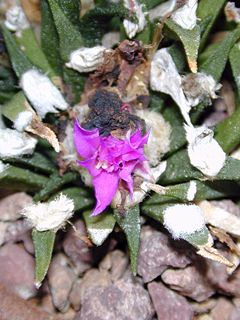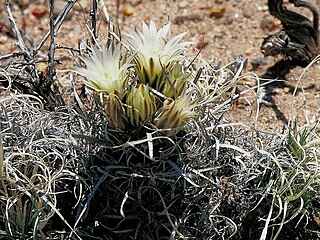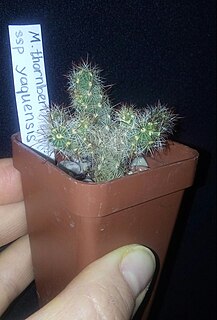
A cactus is a member of the plant family Cactaceae, a family comprising about 127 genera with some 1750 known species of the order Caryophyllales. The word "cactus" derives, through Latin, from the Ancient Greek κάκτος, kaktos, a name originally used by Theophrastus for a spiny plant whose identity is now not certain. Cacti occur in a wide range of shapes and sizes. Most cacti live in habitats subject to at least some drought. Many live in extremely dry environments, even being found in the Atacama Desert, one of the driest places on earth. Cacti show many adaptations to conserve water. Almost all cacti are succulents, meaning they have thickened, fleshy parts adapted to store water. Unlike many other succulents, the stem is the only part of most cacti where this vital process takes place. Most species of cacti have lost true leaves, retaining only spines, which are highly modified leaves. As well as defending against herbivores, spines help prevent water loss by reducing air flow close to the cactus and providing some shade. In the absence of leaves, enlarged stems carry out photosynthesis. Cacti are native to the Americas, ranging from Patagonia in the south to parts of western Canada in the north—except for Rhipsalis baccifera, which also grows in Africa and Sri Lanka.

Epithelantha is a genus of cactus that is native to north-eastern Mexico, and the south-western United States from western Texas to Arizona. There are eight species recognised in the genus Epithelantha. The name Epithelantha refers to the flower position near the apex of the tubercles.

Stenocereus thurberi, the organ pipe cactus, is a species of cactus native to Mexico and the United States. The species is found in rocky desert. Two subspecies are recognized based on their distribution and height. The Organ Pipe Cactus National Monument is named for the species.

Ariocarpus agavoides is a species of cactus. It is endemic to Mexico. It grows in dry shrubland in rocky calcareous substrates.

The cactus wren is a species of wren endemic to the deserts of the southwestern United States and northern and central Mexico. It is the state bird of Arizona, and the largest wren in the United States. Its plumage is brown, with black and white spots as markings. It has a distinctive white eyebrow that sweeps to the nape of the neck. The chest is white, whereas the underparts are cinnamon-buff colored. Both sexes appear similar. The tail, as well as flight feathers, are barred in black and white. Their song is a loud raspy chirrup; akin in the description of some ornithologists to the sound of a car engine that will not start. It is well-adapted to its native desert environment, and the birds can meet their water needs from their diet which consists chiefly of insects, but also of some plant matter. The cactus wren is a poor flier and generally forages for food on the ground. Ornithologists generally recognize seven subspecies, with the exact taxonomy under dispute.

Escobaria minima is a rare species of cactus known by the common names Nellie cory cactus, Nellie's pincushion cactus, birdfoot cactus, and others. It is a very popular species among cactus collectors. This is one reason why it is a highly endangered species in the wild today. This cactus is found only in Brewster County, Texas, in the United States, where there are three populations remaining near Marathon. The cactus is limited to one outcrop in the Marathon Uplift, where it grows in rocky novaculite soils. It was added to the endangered species list in 1979.

Coryphantha ramillosa is a rare species of cactus known by the common names bunched cory cactus and whiskerbush. It is native to the border region between Texas in the United States and Coahuila in Mexico. Because it was believed to be rare and threatened by a number of processes, it was federally listed as a threatened species of the United States in 1979.

Escobaria robbinsorum is a rare species of cactus known by the common names Cochise pincushion cactus and Cochise foxtail cactus. It is native to southern Arizona in the United States, where it is known only from Cochise County, and northern Sonora in Mexico. There are scattered small occurrences on the north side of the border, and one known population to the south. Because of its rarity and a number of threats to remaining plants, the species was federally listed with a threatened status in 1986.

Escobaria sneedii is a rare species of cactus known by the common names Sneed's pincushion cactus and carpet foxtail cactus. It is native to the Chihuahuan Desert, where it occurs in scattered locations in New Mexico, Texas, and Chihuahua. Some plants occurring in Arizona may be included within this species. Botanical authors do not necessarily agree on the circumscription of this species. Most will agree at this point in the research, however, that there are two varieties of Escobaria sneedii, and that both are rare and endangered. The plant is popular with cactus enthusiasts and dealers because of its often petite size and tolerance for moderately cold climates. They have been overharvested from their natural habitat, the main reason why the two varieties, var. sneedii and var. leei, have been federally listed as endangered and threatened, respectively.

Echinocactus horizonthalonius is a species of cactus known by several common names, including devilshead, turk's head cactus, blue barrel cactus, eagle's claw, horse maimer, horse crippler, and visnaga meloncillo. It is native to the southwestern United States and northern Mexico, where it occurs in Chihuahuan Desert and Sonoran Desert habitats, particularly on limestone substrates. One of its varieties is a federally listed endangered species of the United States.

Echinocereus viridiflorus is a species of cactus known by the common names nylon hedgehog cactus, green pitaya, and small-flowered hedgehog cactus. It is native to the central and south-central United States and northern Mexico, where it can be found in varied habitat types, including desert scrub, woodlands, dry grasslands, and short-grass prairie.

Echinomastus mariposensis is a rare species of cactus known by the common names Lloyd's fishhook cactus, golfball cactus, silver column cactus, and Mariposa cactus. It is native to a small section of territory straddling the border between Brewster County, Texas, in the United States and the state of Coahuila in Mexico. It has been federally listed as a threatened species in the United States since 1979.

Pediocactus bradyi is a very rare species of cactus known by the common names Brady's pincushion cactus, Brady's hedgehog cactus, and Marble Canyon cactus. It is endemic to Arizona in the USA, where it is restricted to Marble Canyon in Coconino County, though its exact distribution is not generally advertised due to poaching concerns. It is limited to a specific type of soil, it has a small distribution, and the species is threatened by a number of human activities. This has been a federally listed endangered species of the United States since 1979.

Pediocactus despainii is a rare species of cactus known by the common names Despain's cactus and San Rafael cactus. It is endemic to the state of Utah in the United States, where it is limited to the San Rafael Swell in Emery County, Utah.

Sclerocactus papyracanthus is a species of cactus known by the common names paperspine fishhook cactus, grama grass cactus, paper-spined cactus, and toumeya. It is native to North America, where it occurs from Arizona to New Mexico to Texas and into Chihuahua, Northeastern Mexico.

Echinocereus dasyacanthus is a member of the cactus family, Cactaceae. It is one of about 2000 total species belonging to this family. The cactus is commonly known as Texas rainbow cactus because of the subtle rings or bands of contrasting colors along the stem of the plant. Not all Texas rainbow cacti have the "rainbow" coloration on their stems. Another common name is spiny hedgehog cactus.

Mammillaria thornberi is a species of cactus known by the common names Thornber's fishhook cactus and Thornber's nipple cactus. It is native to Arizona in the United States and Sonora in Mexico.

Ferocactus emoryi, known commonly as Emory's barrel cactus, Coville's barrel cactus and traveler's friend, is a barrel cactus in the genus Ferocactus.

Drymocallis glandulosa, known by the common name sticky cinquefoil and formerly as Potentilla glandulosa, is a plant species in the family Rosaceae.
Peniocereus striatus is a species of cactus known by several common names, including gearstem cactus, cardoncillo, jacamatraca, sacamatraca, and dahlia-rooted cactus. It is endemic to the Sonoran Desert, where it occurs in Baja California, Sinaloa, and Sonora in Mexico and Arizona in the United States.



















